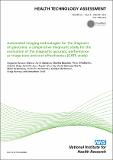Automated imaging technologies for the diagnosis of glaucoma : a comparative diagnostic study for the evaluation of the diagnostic accuracy, performance as triage tests and cost-effectiveness (GATE study)
Abstract
Background: Many glaucoma referrals from the community to hospital eye services are unnecessary. Imaging technologies can potentially be useful to triage this population. Objectives: To assess the diagnostic performance and cost-effectiveness of imaging technologies as triage tests for identifying people with glaucoma. Design: Within-patient comparative diagnostic accuracy study. Markov economic model comparing the cost-effectiveness of a triage test with usual care. Setting: Secondary care. Participants: Adults referred from the community to hospital eye services for possible glaucoma. Interventions: Heidelberg Retinal Tomography (HRT), including two diagnostic algorithms, glaucoma probability score (HRT-GPS) and Moorfields regression analysis (HRT-MRA); scanning laser polarimetry [glaucoma diagnostics (GDx)]; and optical coherence tomography (OCT). The reference standard was clinical examination by a consultant ophthalmologist with glaucoma expertise including visual field testing and intraocular pressure (IOP) measurement. Main outcome measures: (1) Diagnostic performance of imaging, using data from the eye with most severe disease. (2) Composite triage test performance (imaging test, IOP measurement and visual acuity measurement), using data from both eyes, in correctly identifying clinical management decisions, that is ‘discharge’ or ‘do not discharge’. Outcome measures were sensitivity, specificity and incremental cost per quality-adjusted life-year (QALY). Results: Data from 943 of 955 participants were included in the analysis. The average age was 60.5 years (standard deviation 13.8 years) and 51.1% were females. Glaucoma was diagnosed by the clinician in at least one eye in 16.8% of participants; 37.9% of participants were discharged after the first visit. Regarding diagnosing glaucoma, HRT-MRA had the highest sensitivity [87.0%, 95% confidence interval (CI) 80.2% to 92.1%] but the lowest specificity (63.9%, 95% CI 60.2% to 67.4%) and GDx had the lowest sensitivity (35.1%, 95% CI 27.0% to 43.8%) but the highest specificity (97.2%, 95% CI 95.6% to 98.3%). HRT-GPS had sensitivity of 81.5% (95% CI 73.9% to 87.6%) and specificity of 67.7% (95% CI 64.2% to 71.2%) and OCT had sensitivity of 76.9% (95% CI 69.2% to 83.4%) and specificity of 78.5% (95% CI 75.4% to 81.4%). Regarding triage accuracy, triage using HRT-GPS had the highest sensitivity (86.0%, 95% CI 82.8% to 88.7%) but the lowest specificity (39.1%, 95% CI 34.0% to 44.5%), GDx had the lowest sensitivity (64.7%, 95% CI 60.7% to 68.7%) but the highest specificity (53.6%, 95% CI 48.2% to 58.9%). Introducing a composite triage station into the referral pathway to identify appropriate referrals was cost-effective. All triage strategies resulted in a cost reduction compared with standard care (consultant-led diagnosis) but with an associated reduction in effectiveness. GDx was the least costly and least effective strategy. OCT and HRT-GPS were not cost-effective. Compared with GDx, the cost per QALY gained for HRT-MRA is £22,904. The cost per QALY gained with current practice is £156,985 compared with HRT-MRA. Large savings could be made by implementing HRT-MRA but some benefit to patients will be forgone. The results were sensitive to the triage costs. Conclusions: Automated imaging can be effective to aid glaucoma diagnosis among individuals referred from the community to hospital eye services. A model of care using a triage composite test appears to be cost-effective. Future work: There are uncertainties about glaucoma progression under routine care and the cost of providing health care. The acceptability of implementing a triage test needs to be explored.
Citation
Azuara-Blanco , A , Banister , K , Boachie , C , McMeekin , P , Gray , J , Burr , J , Bourne , R , Garway-Heath , D , Batterbury , M , Hernández , R , McPherson , G , Ramsay , C & Cook , J 2016 , ' Automated imaging technologies for the diagnosis of glaucoma : a comparative diagnostic study for the evaluation of the diagnostic accuracy, performance as triage tests and cost-effectiveness (GATE study) ' , Health Technology Assessment , vol. 20 , no. 8 . https://doi.org/10.3310/hta20080
Publication
Health Technology Assessment
Status
Peer reviewed
ISSN
1366-5278Type
Journal article
Collections
Items in the St Andrews Research Repository are protected by copyright, with all rights reserved, unless otherwise indicated.

